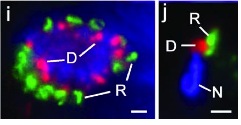The secretory organelles of Toxoplasma gondii orchestrate invasion of the host cell and establish the parasitophorous vacuole. Although much has been learned about the roles played by these organelles in invasion by the tachyzoite stage, little is known about the contents or functions of these organelles during bradyzoite development or pathogenesis. We identified a novel protein that localizes to the rhoptries of the bradyzoite stage, but is absent from the tachyzoite stage. This protein, BRP1, first appears in the nascent rhoptries during the first division of bradyzoite stage development.We observed secretion of BRP1 and other rhoptry proteins into the parasitophorous vacuole during bradyzoite development in vitro, but there was no evidence that this occurs in vivo. Brp1 knockout parasites did not appear to have any developmental or growth defects in vitro, and were able to establish infections in mice both as tachyzoites (via intraperitoneal injection of in vitro-derived tachyzoites) or bradyzoites (via oral gavage using cysts harvested from mouse brain). Mice infected using brain cysts from the brp1 knockout or the control strain developed similar numbers and sizes of brain cysts. Thus BRP1 does not appear to play an essential role in development of the bradyzoite stage, development of brain cysts, or oral infection of new hosts, at least in the mouse model used here. Since we also observed that BRP1 is expressed in the merozoite stages in the gut of infected cats, the coccidian phase of the life cycle may be where BRP1 plays its most important role.

